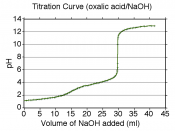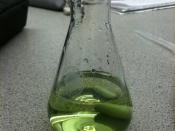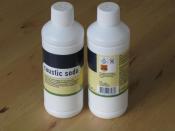Titration Lab Abstract.
The molarity of HCl was determined by titrating the acid, HCl, with a standard base solution, NaOH. It was determined that there was a 1.356 M concentration of HCl, with a very minimal percentage of error of 3.14%.
Introduction.
In order to determine the concentration of an acid in a solution, a neutralization reaction will need to be preformed. In this case the concentration of HCl needs to be determined. This is done by completing a titration of HCl with a NaOH solution. A solution of known concentration added to a measured amount of the solution of an unknown concentration until an indicator signals the end point. The end point is point in a titration where the color changes and neutralization is achieved.
The solution of known concentration is called the standard solution, it this case, NaOH. The standard solution is added to the unknown solution (HCl) using a buret, which is set in a buret stand.
This titration will continue until the solution has reached its end point, where the phenolphthalein indicator causes the solution to change from a clear solution to a shade of red, indicating the end point.
Procedure.
The procedure used in this experiment is located on the ÃÂáÃÂÃÂ¥Titration LabÃÂáÃÂæ handout. There were no variations to this procedure.
Data.
Trial 1 Trial 2 Volume of acid (HCl) 25.0mL 25.0mL Volume of NaOH 33.8mL 33.9mL Analysis and Questions.
1.) The balanced equation for the neutralization reaction that occurred was; HCl(aq) + NaOH(aq) ÃÂáÃÂ÷ NaCl(aq) + H2O(l) 2.) The number of moles of base used in trial one was 0.0338 mol.
NaOH moles "à ¾ÃÂñ 1.00 mol NaOH x 0.0338L = 0.0338 mol.
The number of moles of base used in trial two was; NaOH moles "à ¾ÃÂñ1.00 mol NaOH x 0.0339L = 0.0339...



GOOD
Needs sources.
Concise. BUT Plagiarism is obviously present. Arent you gonna credit people???? hmmm??
Wheres a proper discussion???? hmmm??
ORGANIZED PROPERLY!!
0 out of 0 people found this comment useful.